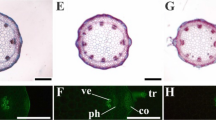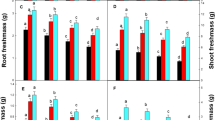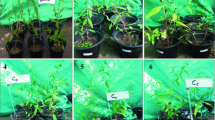Abstract
Copper accumulation and physiological responses to Cu stress in three populations of Elsholtzia haichowensis S. were comparatively studied with pot culture experiments. Seeds of the three populations were respectively collected from Cu contaminated and non-contaminated sites. It was found that the copper accumulation and physiological responses to Cu treatment in the three populations were significantly different. The chlorophyll content and electrolyte leakage were less affected in the populations from contaminated sites than those in the population from non-contaminated site. At high level of copper treatment, the activities of peroxidase and superoxide dismutase in the populations from contaminated sites were significantly induced, while this was not the case for the population from non-contaminated site. Lower copper content was noted in the leaves of plants from contaminated site exposed to higher Cu concentrations when compared to controls. These results indicate that the populations from Cu-contaminated sites are more resistant to copper stress. The reason for this might be related to the fact that, in the populations from Cu-contaminated sites, less Cu was transported to leaves and higher peroxidase and superoxide dismutase activities induced in the plants when subjected to Cu stress.
Similar content being viewed by others
References
Alan, R. W.: 1994, ‘The spectral determination of chlorophyll a and b, as well as total carotenoids, using various solvents with spectrophotometers of different resolution’, Plant Physiol 144, 307–313.
Baker, A. J. M.: 1981, ‘Accumulators and excluders-strategies in the response of plants to heavy metals’, J. Plant Nutr. 3, 643–654.
Berry, W. L. and Wallace, A.: 1981, ‘Toxicity: The concept and relationship to the dose response curve’, J. Plant Nutr. 3, 13–19.
Bowler, C., Van Montageu, T. and Inze, D.: 1992, ‘Superoxide dismutase and stress tolerance’, Annu. Rev. Plant Physiol. Plant Mol. Biol. 43, 83–118.
Castillo, F. J., Miller, P. R. and Greppin, H.: 1987, ‘Extra cellular biochemical markers of photochemical oxidant air pollution damage to Norway spruce’, Experimentia 43, 111–115.
Chettri, M. K., Cook, C. M., Vardaka, E., Sawides, T. and Lanaras, T.: 1998, ‘The effect of Cu, Zn and Pb on the chlorophyll content of the lichens Cladonia convoluta and Cladonia rangiformis’, Environ. Exp. Bot. 39, 1–10.
Cox, R. M. and Hutchinson, T. C.: 1980, ‘The response of root acid phosphatase activity to heavy metal stress in tolerant and non-tolerant clones of two grass species’, New phytol. 86, 359– 364.
Devi, S. R. and prasad, M. N. V.: 1998, ‘Copper toxicity in Ceratophyllum demersum L. (Coontail), a free floating macrophyte: responses of antioxidant enzymes and antioxidants’, Plant Sci. 138, 157–165.
Fang, W. and Kao, C. H.: 2000, ‘Enhanced peroxidase activity in rice leaves in response to excess iron, copper and zinc’, Plant Sci. 158, 71–76.
Giannoplities, C. N. and Ries, S. K.: 1977, ‘Superoxide dismutase purification and quantitative relationship with water-soluble protein in seedling’, J. Plant Physiol. 59, 315–318.
Hsieh and Hsu: 1954, ‘On Elsholtzia haichowensis: An indicator plant for copper’, Bull. Geol. Soc. China 32(4), 360–367 (in Chinese).
Ke, W., **, H., Yang, Y., Wang, W. and Chen, S.: 2001, ‘Analysis on characteristics of phytogeochemistry of Elsholtzia haichowensis in Daye Tonglushan copper mine’, Acta Ecologica Sinica 21(6), 907–912 (in Chinese).
Kronfuss, G., Wieser.G., Havranek, W. M. and Polle, A.: 1996, ‘Effects of ozone and mild drought stress on total and apoplastic guaiacol peroxidase lipid peroxidation on current-year needles of young Norway spruce’, J. Plant Physiol. 148, 203–206.
Kupper, H., Kupper, F. and Spiller, M.: 1996, ‘Environmental relevance of heavy metal-substituted chlorophylls using the example of water plants’, J. Exp. Bot. 47, 259–266.
Landberg, T. and Greger, M.: 1996, ‘Differences in uptake and tolerance to heavy metals in Salix from unpolluted and polluted areas’, Applied Geochemistry 11, 175–180.
Lefébvre, C. and Vernet, P.: 1990, ‘Microevolutionary processes on contaminated deposits’, in: J. Shaw (ed), Heavy Metal Tolerance in Plants: Evolutionary Aspects, CRC Press, Boca Raton, FL, USA, pp. 285–300.
Leopld, I., Günther, D., Schmidt, J. and Neumann, D.: 1999, ‘Phytochelatins and heavy metal tolerance’, Phytochemistry 50, 1323–1328.
Liu, J., **ong, Z., Li, T. and Huang, H.: 2004, ‘Bioaccumulation and ecophysiological responses to copper stress in two populations of Rumex dentatus L. from Cu contaminated and non-contaminated sites’, Environ. Exp. Bot. 52, 43–51.
Lolkema, P. C.: 1986, ‘The possible role of metallothineins in copper tolerance of silene cucubalus’, Planta 162, 174–179.
Luna, C. M., Gonzalez, C. A. and Trippi, V. S.: 1994, ‘Oxidative damage caused by excess of copper in oat leaves’, Plant Cell Physiol. 35, 11–15.
Macnair, M. R.: 1987, ‘Heavy metal tolerance in plants: A model evolutionary system’, Trends Ecol. Evol. 2, 354–359.
Maribel, L. D. and Satoshi, T.: 1998, ‘Antioxidant responses of rice seedlings to salinity stress’, Plant Sci. 135, 1–9.
Nishizono, H.: 1987, ‘The role of the root cell wall in the heavy metal tolerance of Athyrium yokoscense’, Plant and Soil 101, 15–20.
Peters, J. L., Castillo, F. J. and Heath, L.: 1989, ‘Alterations of extra cellular enzymes in pinto bean leaves upon exposure to air pollutants, ozone, and sulfur dioxide’, Plant Physiol. 89, 159– 164.
Peterson, P. J.: 1983, ‘Adaptation to toxic metals’, in: D.A. Robb and W.S. Pierpoint (ed.), Metals and Micronutrients: Uptake and Utilization by plants, Academic Press, London, pp. 51–69.
Prasad, M. N. V., Malec, P., Waloszek, A., Bojko, M. and Strzalka, K.: 2001, ‘Physiological responses of Lemna trisulca L. (duckweed) to cadmium and copper bioaccumulation’, Plant Sci. 161, 881–889.
Richard, K. D., Schott, E. J., Sharma, Y. K., Davis, K. R. and Gardner, R. C.: 1998, ‘Aluminum induces oxidative stress genes in Arabidopsis thaliana’, Plant Physiol. 116, 409–418.
Scalet, M., Federice, R., Guido, M.C. and Manes, F.: 1995, ‘Peroxidase activity and polyamine changes in response to ozone and simulated acid rain in Aleppo pine needles’, Environ. Exp. Bot. 35, 417–425.
Tang, S., Wilke, B. M. and Huang, C.: 1999, ‘The uptake of copper by plants dominantly growing on copper mining spoils along the Yangtze River, the People's Republic of China’, Plant and Soil 209, 225–232.
Tukendorf, A.: 1987, ‘Copper binding in roots by cytosol proteins in vitro’, Plant physiol. 130, 201–209.
Weckx, J. E. J. and Clijsters, H. M. M.: 1996, ‘Oxidative damage and defense mechanism in primary leaves of Phaseolus vulgaris as a result of root assimilation of toxicity amounts of copper’, Physiol. Plant 96, 506–512.
Wierzbicka, M.: 1998, ‘The adaptation of Silene vulgaris to growth on a calamine waste heap (S. Poland)’, Environment Pollution 101, 415–426.
Yamasaki, H., Sakihama, N. and Ikehara, N.: 1997, ‘Flavbonoid-peroxidase reaction as a detoxification mechanism of plant cells against H2O2’, Plant Physiol. 115, 1405–1412.
Author information
Authors and Affiliations
Corresponding author
Rights and permissions
About this article
Cite this article
Liu, J., **ong, Z. Differences in Accumulation and Physiological Response to Copper Stress in three Populations of Elsholtzia haichowensis S.. Water Air Soil Pollut 168, 5–16 (2005). https://doi.org/10.1007/s11270-005-0215-z
Received:
Accepted:
Issue Date:
DOI: https://doi.org/10.1007/s11270-005-0215-z




